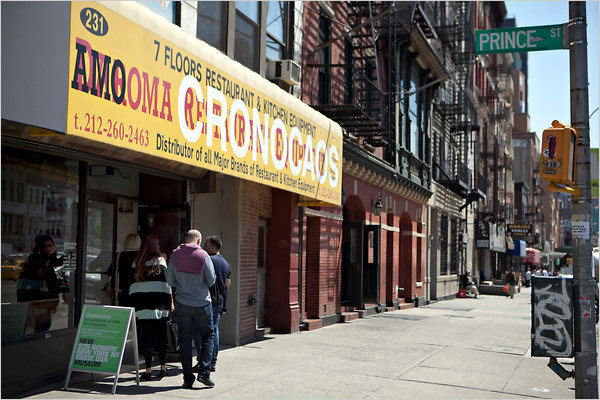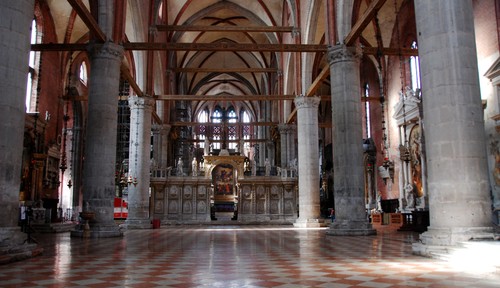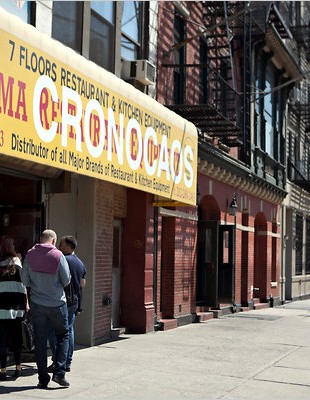Nicolai Ouroussoff teams up with Dutch architect and uber-gobbledegook-meister Rem Koolhaas to sow more confusion regarding principles that are fairly obvious to most people. For example, it is obvious to most that it is good to preserve things which are worth preserving. Likewise, only get rid of something when you can replace it with something better. Apparently, these common sense principles escape Koolhaas and Ouroussoff, who evidently suffer from an irrational fear of old things.
+ + +
An Architect’s Fear That Preservation Distorts
By NICOLAI OUROUSSOFF
Has preservation become a dangerous epidemic? Is it destroying our cities?
That’s the conclusion you may come to after seeing “Cronocaos” at the New Museum. Organized by Rem Koolhaas and Shohei Shigematsu, a partner in Mr. Koolhaas’s Office for Metropolitan Architecture, the show draws on ideas that have been floating around architectural circles for several years now — particularly the view among many academics that preservation movements around the world, working hand in hand with governments and developers, have become a force for gentrification and social displacement, driving out the poor to make room for wealthy homeowners and tourists.
[Is gentrification not a result of demand outstripping supply? If land values rise as a result of preservation policies, surely this means that we need more, not less, preservation. Here is a clear sign that people like these neighborhoods, and we can help the poor best by providing more of them so that prices come down.]
Mr. Koolhaas’s vision is even more apocalyptic. A skilled provocateur, he paints a picture of an army of well-meaning but clueless preservationists who, in their zeal to protect the world’s architectural legacies, end up debasing them by creating tasteful scenery for docile consumers while airbrushing out the most difficult chapters of history. The result, he argues, is a new form of historical amnesia, one that, perversely, only further alienates us from the past.
[To me, “tasteful scenery” is a good thing. And “airbrushing out the difficult chapters of history” probably means taking out the trash–also a good thing. What Koolhaas’ really wants is to use a few problems with modern preservation philosophy as a weapon to gut the original purpose of preservation, i.e., to defend our living architectural traditions and identities. Progress–true progress–is achieved by generations and generations preserving the good, and getting rid of the bad when they can make an improvement. True preservation does not alienate us from the past, it makes the past continually relevant to the present.]
“Cronocaos” was first shown at the 2010 architecture biennale in Venice, the ultimate example of what can happen to an aged city when it is repackaged for tourists. In New York the show is housed in a former restaurant-supply store next to the museum on the Bowery, in a neighborhood where the threats to urban diversity include culture as well as tourism. The Bowery’s lively bar scene has been pushed out by galleries and boutiques. CBGB, the former rock club, is a John Varvatos store.
[Ouroussoff’s conflation of Venice and CBGB’s is breath-taking. Let us pass over a consideration of the values of a man who would do such a thing, and go directly to what he says about Venice. Venice’s status today as a museum city has little to do with an overzealous sense of preservation, a “repackaging for tourists,” and a lot to do with historical realities and it’s siting. Venice’s lagoon setting was an advantage in the Middle Ages when it provided an excellent defense and when it was an important port on the trade route with the Orient. But with the fall of Constantinople to the Turks, and the discoveries of America and the Cape of Good Hope route to Asia, its days as an economic powerhouse were numbered. The fact that Venice today still provides a living for its citizens through tourism is due entirely to the preservation of its beautiful architecture. Less beautiful cities have not done so well with the passage of time. As for the Bowery, “urban diversity” is code for drug dealers and prostitutes, and it’s a form of diversity most people would rather do without. The same argument is often made for Times Square. Few people miss the Times Square of the 70s.]
To highlight this transformation, Mr. Koolhaas and Mr. Shigematsu have kept the supply store’s yellow awning, painting the show’s title directly over the old lettering. Inside, the architects drew a line down the middle of the space, transforming one side into a pristine white gallery and leaving the other raw and untouched.
The result is startling. The uneven, patched-up floors and soiled walls of the old space look vibrant and alive; the new space looks sterile, an illustration of how even the minimalist renovations favored by art galleries today, which often are promoted as ways of preserving a building’s character, can cleanse it of historical meaning. (To sharpen the contrast further, Mr. Koolhaas scattered a few beat-up tables and chairs, salvaged when CBGB was closed five years ago, throughout the room.)
[Ouroussoff is right that minimalism looks sterile–I think that’s the point of minimalism. The anti-dote to sterility, however, is not the accumulation of junk, as mere accumulation does not historical meaning make. The anti-dote is a meaningful renovation (from the Latin renovatio, meaning renewal). Take a gander at these slides, and ask yourself whether you’d like your home treated one way or the other. It’s a false choice. That floor, for example, simply needs to be redone and improved.]
This has become a global phenomenon. All over the world, historic centers are being sanitized of signs of age and decay, losing any sense of the identity that buildings accumulate over time. Facades are carefully scrubbed clean; interiors, often blending minimalist white walls and a few painstakingly restored historic details, are reduced to a bland perfection. And new buildings are designed in watered-down period styles, further eroding the distinction between what’s real and what’s fake, and producing what Mr. Koolhaas calls a “low-grade, unintended timelessness.”
[A few points here. First, the phrase “sanitized of signs of age and decay” is a disparaging way to describe what is a good and natural practice. It is good and natural to restore and preserve what is beautiful in our cities. An old building does not have to look decayed to be meaningful. Second, Ouroussoff is correct that the renovation of our patrimony with a combination of minimalism and watered-down architecture is a soul-sapping exercise. The solution is to renovate our patrimony in the spirit with which it has been handed down to us, without scrubbing away its fine grain, so that we have something of value to hand down to the next generation. Third, this distinction between what is real and what is fake is a canard designed to deplete people’s confidence in their desire to preserve their traditions. There is nothing fake about modern traditional architecture. The truth is, the inhuman architectural environment into which the Koolhaas and Ouroussoff would like to shoehorn humanity is what is completely fake. It is fake because it is based on a fictional account of human nature.]
Mr. Koolhaas argues that this process continues to spread. Using an assortment of graphs and charts, he claims that 12 percent of the earth’s surface has already been landmarked by groups like Unesco, and that figure is expected to rise steeply in the near future. What’s more, the age of what is being preserved continues to shrink. In the late 19th century only ancient monuments received legal protection; today buildings that are 30 years old are regularly listed as historic sites. (Mr. Koolhaas’s own architecture is part of this trend. A house he designed in Bordeaux, France, was declared a national monument only three years after its completion in 1998.)
[The steady expansion of the category of “historic site” should be taken by the architectural profession as a rebuke to its recent efforts. People by now rightly expect architects to make a place uglier, so preservation is their only practical defense. The solution is for the profession to clean up its act. Unfortunately, it has not. Rather, it has co-opted the preservation movement, such that buildings which would not otherwise stand the test of time, like Koolhaas’ house in Bordeaux, are protected with legislation, and old buildings which have stood the test of time cannot be renovated in the spirit in which they were designed. Preservation legislation now actively forces additions and renovations to historic buildings to be incompatible with the original. More on that here.]
This phenomenon is coupled with another disturbing trend: the selective demolition of the most socially ambitious architecture of the 1960s and ’70s — the last period when architects were able to do large-scale public work. That style has been condemned as a monstrous expression of Modernism.
[Does anyone really care if it was socially ambitious? It was a complete social disaster, and style was but a minute part of the problem.]
In Germany monuments like the Palast der Republik, whose government offices, restaurants and nightclubs were once the social heart of East Berlin, became shorthand for a period many West Germans wanted to forget. Kisho Kurokawa’s 1972 capsule tower, one of the most radical housing experiments built in postwar Japan, lies in a state of ruin, awaiting demolition. To Mr. Koolhaas, these examples are part of a widespread campaign to stamp out an entire period in architectural history — a form of censorship that is driven by ideological as much as aesthetic concerns.
[Censorship? Wow. The suggestion that there is a partisan political motivation here is galling. Perhaps it is Koolhaas who is putting his Marxist concerns ahead of anything else. There is no vast conspiracy to stamp out an entire period of architectural history. What Koolhaas is having trouble grappling with is the natural human impulse to rid one’s surroundings of ugliness. The fact that almost everything built during a particular period of architectural history is ugly is of no importance to the average citizen.]
The New Museum show is essentially a manifesto, of course, but what saves it from becoming pure polemic is that Mr. Koolhaas is a first-rate architect as well as an original thinker. Some of the best parts of the show involve his efforts to find ways out of this mess.
[In fact, Mr. Koolhaas’ architecture is completely polemical.]
A 1995 competition design for an expansion of Zurich international airport sought to make sense of what had become a confusing labyrinth of mismatched terminals built over several decades. Rather than tear down the existing structures, Mr. Koolhaas proposed filling in leftover spaces between them with centralized entrance halls and new retail zones. He then created a circulation route to tie it all together. The experience would have been more like traveling though a real city than through a conventional airport. By keeping the various historical layers intact, and playing up their differences, he aimed to breathe new life into a dead environment. (The plan was rejected.)
[Read Koolhaas’ bloated description of the project on his website. Here’s a sound bite: “Perhaps only a paroxysm of the pragmatic, a fanatical fixation on the ‘now,’ on the most concrete and actual conditions, can avoid the futility of forward-looking strategies, whose failure is prefigured by the glaring imperfections of the present.” If this is not polemical, I don’t know what is. The project which resulted from this theory-speak is an unintelligible mess, and its rejection is perfectly understandable.]
In another, more extreme proposal, from 2003, Mr. Koolhaas suggested creating preservation sectors in Beijing, in which everything from traditional hutongs to postwar Communist housing blocks would be protected, along with the way of life they housed. The rest of the city would be a kind of free-for-all, where planners and architects could experiment with new ideas and urban strategies without the crushing burden of history.
[Again, this is pure polemic. There would be nothing free about this vision. It is a form of architectural apartheid, designed to keep traditional architecture in tightly circumscribed bantustans. For architects who know what they are doing, history is not a crushing burden, it is a liberating standard and a challenging responsibility.]
Not all of his ideas are viable; some seem intended mainly to challenge conventional wisdom about preservation and its benefits, and in doing so, to liberate architecture just a little from stale ideas. Yet Mr. Koolhaas’s bigger point is worth paying attention to: in the realm of preservation, as in so much else, we seem to have become a world terrified of too much direct contact with reality.
[The opposite is true. Koolhaas proposes a complete divorce from reality, especially the reality of human nature. He proposes a two-class system: the unwashed masses who do not know what is good for them and who must be weaned from an irrational nostalgia for “dead architecture,” and the architectural politburo which decides what is good based on ever-changing, opportunistic criteria and a complete absence of standards.]
+ + +
Koolhaas and Ouroussoff pretend to confuse the true spirit of preservation with hoarding. A hoarder makes no value judgments about what should be kept. It all stays, and the result is his home is a dump. If we keep everything, we wind up preserving nothing–and that, my friends, is what Koolhaas is really all about. His endgame is the embalming of our architectural identity. He is suffering from an acute case of cronophobia, the irrational fear that old things might still be alive to us today.
Consider another approach taken by the Venetians toward the beautiful church Santa Maria Gloriosa dei Frari. Completed in the early 14th century, it has been lovingly embellished by generations and generations, all meaningfully, and without any angst about what is authentic and what is not. It has also suffered through suppression, looting, and radical restoration. I Frari has been through it all. It is almost 700 years old, yet because it has been properly cared for, it still looks fresh as a garden daisy. And it is mobbed by visitors year-round who yearn to follow its example, not only in the preservation and handing down of churches, but also our cities, our homes, our culture.

View of the nave of Santa Maria Gloriosa dei Frari, looking through the gate of the Schola Cantorum toward Titian’s sumptuous Assumption of the Virgin over the high altar. Note that no tiles in the floor have been left missing for the sake of historical meaning.
[Image source]

![View of the nave of Santa Maria Gloriosa dei Frari, looking through the gate of the Schola Cantorum toward Titian's sumptuous Assumption of the Virgin over the high altar. Note that no tiles in the floor have been left missing for the sake of historical meaning.
[Image source]](https://www.marcantonioarchitects.com/blog/wp-content/uploads/2011/05/frari-960x642.jpg)


![View of the nave of Santa Maria Gloriosa dei Frari, looking through the gate of the Schola Cantorum toward Titian's sumptuous Assumption of the Virgin over the high altar. Note that no tiles in the floor have been left missing for the sake of historical meaning.
[Image source]](https://www.marcantonioarchitects.com/blog/wp-content/uploads/2011/05/frari-310x420.jpg)

Do architects dare become politicians?
a city would not benefit from a selective memory that only caters to classically-branded architecture
I’m not sure what you mean exactly by “classically branded architecture.” I’m standing up for 2,500 years worth of tradition and for a people’s right to their identity.